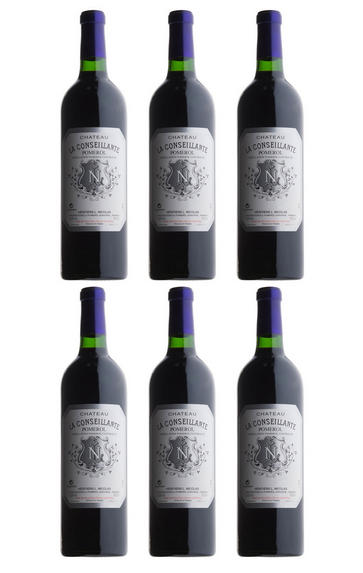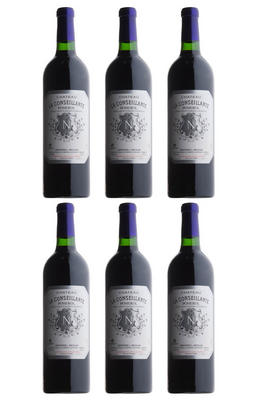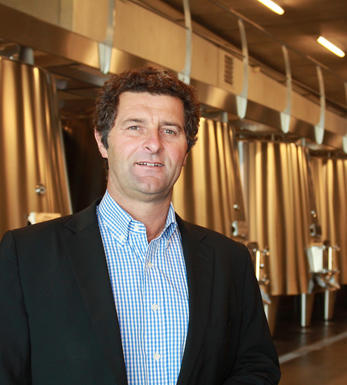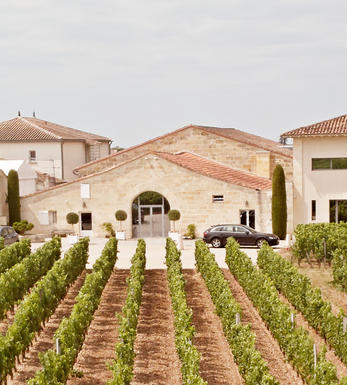
Château la Conseillante, Vertical (2001 to 2002, 2004 to 2007), Six-Bottle Assortment Case

About this WINE

Chateau la Conseillante
Château La Conseillante is amongst the crème de la crème of Pomerol producers. It can trace its history back to 1735 and has been in the hands of the Nicolas family since 1874.
La Conseillante's 13 hectares of vineyards are located on a plateau in eastern Pomerol on the boundary with the St-Emilion appellation. Its vineyards border those of L`Evangile, Petit-Village, Vieux Château-Certan and Cheval Blanc.
La Conseillante is a blend of 70% Merlot, 25% Cabernet Franc and 5% Malbec. The grapes are harvested by hand and are then fermented in temperature-controlled stainless steel vats. The wine is then aged in small oak casks (90% new) for 18-20 months. It is bottled unfiltered.

Pomerol
Pomerol is the smallest of Bordeaux's major appellations, with about 150 producers and approximately 740 hectares of vineyards. It is home to many bijou domaines, many of which produce little more than 1,000 cases per annum.
Both the topography and architecture of the region is unremarkable, but the style of the wines is most individual. The finest vineyards are planted on a seam of rich clay which extends across the gently-elevated plateau of Pomerol, which runs from the north-eastern boundary of St Emilion. On the sides of the plateau, the soil becomes sandier and the wines lighter.
There is one satellite region to the immediate north, Lalande-de-Pomerol whose wines are stylistically very similar, if sometimes lacking the finesse of its neighbour. There has never been a classification of Pomerol wines.
Recommended Châteaux : Ch. Pétrus, Vieux Ch. Certan, Le Pin, Ch. L’Eglise-Clinet, Ch. La Conseillante, Ch. L’Evangile, Ch. Lafleur, Trotanoy, Ch. Nenin, Ch. Beauregard, Ch. Feytit-Clinet, Le Gay.

Merlot
The most widely planted grape in Bordeaux and a grape that has been on a relentless expansion drive throughout the world in the last decade. Merlot is adaptable to most soils and is relatively simple to cultivate. It is a vigorous naturally high yielding grape that requires savage pruning - over-cropped Merlot-based wines are dilute and bland. It is also vital to pick at optimum ripeness as Merlot can quickly lose its varietal characteristics if harvested overripe.
In St.Emilion and Pomerol it withstands the moist clay rich soils far better than Cabernet grapes, and at it best produces opulently rich, plummy clarets with succulent fruitcake-like nuances. Le Pin, Pétrus and Clinet are examples of hedonistically rich Merlot wines at their very best. It also plays a key supporting role in filling out the middle palate of the Cabernet-dominated wines of the Médoc and Graves.
Merlot is now grown in virtually all wine growing countries and is particularly successful in California, Chile and Northern Italy.


Buying options
Add to wishlist
Description
2001 - What a treat to drink. Aromas of blackberries, minerals and dried flowers follow through to a medium to full body, with very silky and caressing tannins and a long, beautiful finish. Delicious now but will improve with age. James Suckling, WineSpectator.com, 91/100 Points. April 2007
2002 - Good colour. Plenty of depth and concentration on the nose. Quite tannic too. Full-bodied and vigorous. Lots of grip and intensity. Good ripe tannins. Lovely ripe, harmonious fruit. This has real size. Profound and long. Very elegant. Marvellous finish. This is fine. From 2008. Clive Coates - The Vine - Jun-2003
2004 - Very dark and opulent crimson. Looks very healthy and intense. Very fragrant. Meaty and savoury with great Pomerol plushness underneath. Lovely velvety richness and well-resolved tannins. Just gorgeous now (already !) Fine tannins well hidden with a little alcohol on the end. Good value. Drink 2009 – 2022. Jancis Robinson MW, JancisRobinson.com, 18.5/20 points. February 2011
2005 - Displaying spectacular aromatics of mulberry, blueberry and raspberry fruit, a dense ruby/purple color, and sweet floral notes, in the mouth the 2005 La Conseillante is not as broad and powerful as Petrus, Trotanoy, Hosanna or Lafleur, but it is gorgeously silky, elegant and stylish. This medium-bodied, savory wine is a graceful, provocative and compelling Pomerol to drink now and over the next 25 years. Robert Parker Wine Advocate #219 97/100 Jun 2015
2006 - The 2006 Château La Conseillante had perhaps the most show-stopping bouquet out of all seventy-odd 2006s that I tasted at ten years. It explodes from the glass with raspberry coulis, kirsch, honey and marmalade, so much so that I am not sure if I would nail it as a Bordeaux, let alone a Pomerol! It is precocious and very attractive. The palate is medium-bodied with succulent ripe red cherry and strawberry fruit, plenty of black truffle, fine tannin and well-judged acidity. This is an opulent, decadent La Conseillante that is atypical of the vintage and yet you totally fall for its charms. What it might lack in subtlety, it makes up for in sheer charm. 93/100 Neal Martin, RobertParker.com, May 2016
2007 - The 2007 La Conseillante has a very pretty bouquet with tarry black cherry fruit, black truffle and incense. I appreciate the focus and freshness on this Pomerol. The palate is medium-bodied with fine tannin, a keen line of acidity, very focused with plenty of freshness and tension on the finish. Maybe the best bottle of this I have encountered, this La Conseillante is well worth hunting down. Tasted February 2017. Drink date 2017 - 2030. 92/100 Neal Martin, Wine Advocate (231), June 2017
wine at a glance
Delivery and quality guarantee